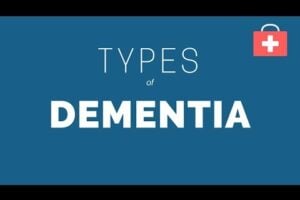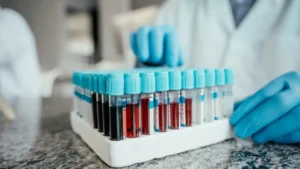This fall, NanoSomiX will begin providing their Alzheimer’s blood test to researchers and pharmaceutical companies. Find out how the test correctly classifies 96% of Alzheimer’s cases and can identify pre-symptomatic patients up to 10 years prior to a clinical diagnosis.
ALISO VIEJO, Calif.– A new blood test reliably predicts whether a person is likely to develop Alzheimer’s Disease (AD) up to 10 years before the disease is diagnosed, according to a multi-site study recently published in the Alzheimer’s Association journal Alzheimer’s & Dementia.
The study was conducted by Ed Goetzl, M.D. and others. Researchers used a unique approach to identify and isolate a well-known neural biomarker called p-tau, which previously had not been detectable in blood. Study results showed that the assay could correctly classify 96.4% of AD cases and could identify pre-symptomatic patients up to 10 years prior to diagnosis. Consisting of two phases, the study involved a total of 162 subjects, half of them Alzheimer’s disease patients and half of them controls.
NanoSomiX, Inc. holds the rights to commercialize this blood assay. This fall, the company will begin providing the test to researchers and pharmaceutical companies who are studying treatments for AD. This is the flagship service for the company, which is developing a platform of blood-based assays based on its proprietary process. This platform of assays will be focused on the detection, tracking and management of neurodegenerative, neuroinflammatory, and neurotraumatic diseases.
This first blood test from NanoSomiX measures the p-tau biomarker. Previous studies have shown that p-tau is closely correlated with the development of AD.
Because p-tau is considered to be a well characterized biomarker currently used by neurologists, the emergence of a blood test for detection could transform the landscape of AD testing. Prior to development of the new blood test, p-tau had to be extracted from cerebral spinal fluid (CSF) with a process called a spinal tap – a procedure that is costly and traumatic for patients.
“Our first blood assay will be available this fall for researchers and pharmaceutical companies that want to use p-tau as a biomarker for drug evaluation or patient sample enrichment in their clinical trials,” said John Osth, President and CEO of NanoSomiX. “We are interested in collaborating or partnering with pharmaceutical companies to generate additional data.” All NanoSomiX testing is performed in a CLIA-approved lab, a federally regulated clinical laboratory authorized to handle human specimens.
According to the 2013 Alzheimer’s Association’s Facts and Figures report, AD is the most common type of dementia affecting people over 65 years of age and is the sixth-leading cause of death. In the U.S., it is estimated that 5.2 million individuals of all ages have the disease. This number is projected to nearly triple by 2050 as the number of people aged 65 and older continues to increase.
Traditionally, patients were diagnosed with AD when cognitive impairment became obvious and they were having trouble functioning in their daily lives. More recent research has shown that Alzheimer’s-related changes in the brain begin many years before the onset of symptoms. Researchers and drug companies are now focused on developing therapies to be administered before the onset of cognitive decline.
“Researchers have not yet found a cure or effective treatment for Alzheimer’s disease. But being able to predict and track the development of the disease up to 10 years before it appears is an essential step toward finding effective therapies,” said Osth.
The newly published study was supported in part by the National Institutes of Health, the University of Kentucky Alzheimer’s Disease Center, and NanoSomiX, Inc.
Study sites included:
- Laboratory of Neurosciences, National Institute on Aging (Baltimore, Md.)
- The Departments of Neurology and Neuroscience, Georgetown University (Washington, D.C.)
- The Department of Neurology, University of Rochester (Rochester, N.Y.)
- The Department of Neurology, University of California-San Francisco (San Francisco, Calif.)
- Sanders-Brown Center on Aging, University of Kentucky (Lexington, Ky.)
- The Department of Neurology, Mayo Clinic (Rochester, Minn.)
- The Jewish Home of San Francisco (San Francisco, CA)
- University of California, Irvine (Irvine, CA)
Resources
Alzforum: Exosomes Stand Out as Potential Blood Biomarkers
NIH Blog: NIH-supported study shows promise for blood test for Alzheimer’s disease
About NanoSomiX
NanoSomiX, Inc. is dedicated to providing insight to researchers, clinicians, patients, their families and caregivers through the detection and management of neurodegenerative disorders via easy-to-perform, blood-based assays. The company’s flagship product is the first blood assay developed for the measurement of p-tau, a biomarker that studies have shown is tightly correlated with Alzheimer’s disease (AD). NanoSomiX is also developing additional blood-based assays for the management of AD as well as targeting other disease states. All testing is performed in a CLIA-approved laboratory in Irvine, Calif. The company is headquartered in Aliso Viejo, Calif. For more information, see www.nanosomix.com.











